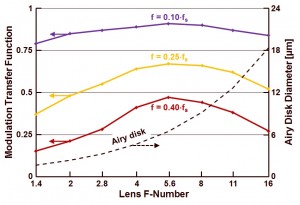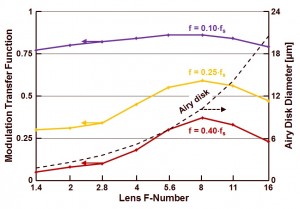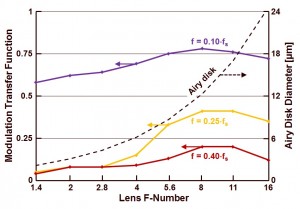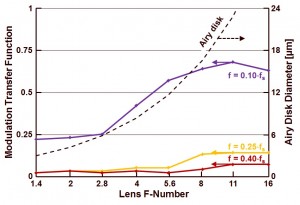Last time the MTF results obtained with green light (525 nm) were highlighted. This time those results are compared with the MTF measurements done with blue light (470 nm), red light (630 nm) and near-IR light (850 nm). To compare the results, the measured MTF is shown as a function of the F-number of the lens, and at 3 different spatial frequencies : 0.1, 0.25 and 0.4 times the spatial sampling frequency. Figures 1, 2, 3 and 4 illustrate the outcome of the measurements, respectively for the blue, green, red and near-IR light. All results reported come from the same sensor, same camera, same lens (Tamron, 8mm) and same measurement set-up. All four figures also illustrate the size of the Airy disk as a function of the lens F-number (second vertical axis).
Figure 1 : MTF as a function of lens F-number at 0.1, 0.25 and 0.4 times the sampling frequency, measurements done with blue light input (470 nm).
From figure 1 it can be learned that the optimum setting of the lens F-number is equal to F5.6. At F16 the Airy disk is equal to 3 times the pixel pitch, and this large size of the blurred spot limits the MTF at the high F-numbers.
Figure 2 : MTF as a function of lens F-number at 0.1, 0.25 and 0.4 times the sampling frequency, measurements done with green light input (525 nm).
Changing the light from blue to green shifts the optimum setting of the lens F-number to F8. This seems to be in contradiction to what can be expected from the diffraction limits of the lens, because the size of the Airy disk has grown to about 3.5 times the pixel pitch for F16, it would be expected that the optimum setting for the F-number would shift to a lower F-number in comparison to the measurement shown in Figure 1.
Figure 3 : MTF as a function of lens F-number at 0.1, 0.25 and 0.4 times the sampling frequency, measurements done with red light input (630 nm).
The “sweet spot” for the lens setting shifted slightly to have an optimum between F8 and F11, despite of a further growth of the Airy diameter. So the trend of shifting to larger F-numbers when also the wavelength of the light is increasing, seems to be consistent, even if the diffraction is increasing.
Figure 4 : MTF as a function of lens F-number at 0.1, 0.25 and 0.4 times the sampling frequency, measurements done with near-IR light input (850 nm).
Not visible is the Airy disk diameter at F16, being equal to more than 5.5 times the pixel pitch. So at the highest F-number, the MTF absolutely will be limited by the diffraction of the lens, but nevertheless the best MTF values are still measured around F11.
As already mentioned in the previous blog, the MTF of the camera system (= lens + sensor + processing) is mainly determined by 3 factors :
- Diffraction of the lens, being a strong function of the F-number and which is worst for F16 and best for F1.4,
- Aberrations of the lens, being worst for the lowest F-numbers,
- Cross talk in the pixels (optical as well as electrical), expected to be worst for the lowest F-numbers as well, because for these settings of the lens, the angle under which the rays hit the sensor deviate the most from the normal.
The major observation of shifting the optimum lens F-number (for MTF performance) to larger F-values, despite of the increasing wavelengths, indicates that cross-talk contribution to the deterioration of the MTF is a major factor for lower F-numbers. The MTF drop is remarkable in the case the F-number is kept constant but the wavelength of the light source is changed. So the wavelength of the light has a major influence, the latter is due to the lower absorption coefficient of the silicon for these longer wavelengths.
As a general conclusion : the MTF of the device-under-test is seriously suffering from cross-talk between the pixels, in particular when the light is coming under angles that deviate more from the normal (= low F-numbers) and/or when the light can penetrate deeper into the silicon (= longer wavelengths).
Albert, 14-11-2014.




Hi Albert,
The lens can also have enough chromatic aberration that the focus moves with wavelength, which would also shift the best sharpness to a larger f#.
100 % correct ! Albert.
Hi,
Did you refocus after changing the wavelength ?